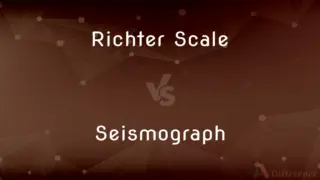Back Titration vs. Direct Titration — What's the Difference?
By Tayyaba Rehman — Published on November 30, 2023
Back Titration involves two-step reactions, first reacting the analyte with an excess of reagent, then titrating the excess. Direct Titration measures the analyte directly in a single step.

Difference Between Back Titration and Direct Titration
Table of Contents
ADVERTISEMENT
Key Differences
Back Titration is a method used when the reactant doesn't react directly with the titrant or when the direct titration endpoint is difficult to observe. In Back Titration, an excess amount of a known reagent is added to the analyte. This reaction proceeds to completion. Following this, the remaining excess reagent is then titrated with another reagent. The difference between the added known reagent and the amount titrated gives the amount of substance initially present.
On the contrary, Direct Titration is the straightforward method where the analyte is directly reacted with the titrant. Here, the titrant of known concentration is added to the analyte until the reaction is complete, which is usually indicated by a color change due to an indicator. Direct Titration is commonly used because of its simplicity and directness.
The choice between Back Titration and Direct Titration depends on the nature of the reaction and the precision required. For compounds that don't easily or quickly react with titrants, Back Titration is preferred. Direct Titration is ideal for quick and clear reactions with a visible endpoint.
A key difference to note is the efficiency. Direct Titration typically takes less time since it's a one-step process, while Back Titration, being a two-step method, might be lengthier. However, Back Titration can sometimes be more accurate, especially in scenarios where the endpoint in a Direct Titration is ambiguous.
To summarize, while both methods aim to determine the concentration of a substance, Back Titration is a two-step method used for substances that don't readily react with titrants or have unclear endpoints, whereas Direct Titration provides a direct measure in a single step.
ADVERTISEMENT
Comparison Chart
XProcess
Two-step reaction.
Single-step reaction.
Efficiency
Can be lengthier due to two steps.
Generally quicker.
Application
Used when direct reaction with titrant is problematic.
Used for reactions with clear endpoints.
Endpoint
Determined after titrating excess reagent.
Determined once analyte reacts completely.
Accuracy
Can be more precise for unclear endpoints.
Direct and typically precise.
Compare with Definitions
Back Titration
Involves reacting the analyte with excess known reagent first.
Using Back Titration, she first added an excess of acid to the base.
Direct Titration
A straightforward titration method where analyte reacts directly with titrant.
The reaction's clarity made Direct Titration the method of choice.
Back Titration
A titration method involving a two-step reaction process.
The chemist employed Back Titration as the endpoint was unclear in a direct method.
Direct Titration
Endpoint is achieved once the analyte is completely reacted.
Using Direct Titration, the endpoint was clearly indicated by the color change.
Back Titration
Helps determine the actual amount of substance in the sample.
Through Back Titration, he calculated the exact amount of calcium in the sample.
Direct Titration
Provides a direct measure of the substance's concentration.
The Direct Titration revealed the solution's exact molarity.
Back Titration
Remaining excess reagent is then titrated to find its quantity.
The Back Titration technique revealed the unused acid through a secondary titration.
Direct Titration
Typically quicker than Back Titration due to its one-step nature.
She preferred Direct Titration for its efficiency and speed.
Back Titration
Employed when the direct titration endpoint is ambiguous.
Due to the sample's unique properties, Back Titration was more reliable.
Direct Titration
Employed for reactions with visible and clear endpoints.
Direct Titration was chosen due to the prominent endpoint.
Common Curiosities
Why might one use Back Titration over Direct Titration?
Back Titration is used when the analyte doesn't react directly with the titrant or when the endpoint is hard to observe.
Does every titration have a visible endpoint?
Not always, which is why methods like Back Titration exist.
Is Direct Titration suitable for all types of reactions?
No, it's mainly for reactions with clear and quick endpoints.
What's the primary goal of both titration methods?
Both aim to determine the concentration of a substance.
What defines Direct Titration?
Direct Titration is a single-step method where the analyte directly reacts with the titrant.
Which method is generally quicker?
Direct Titration is typically quicker due to its one-step nature.
When is the titrant added in Direct Titration?
In Direct Titration, the titrant is added until the analyte is completely reacted.
What is Back Titration?
Back Titration involves a two-step process where the analyte first reacts with an excess of a known reagent, and then the remaining reagent is titrated.
Is Back Titration always a two-step process?
Yes, Back Titration first involves reacting the analyte with an excess reagent and then titrating the excess.
How is the endpoint determined in Direct Titration?
In Direct Titration, the endpoint is achieved when the analyte is completely reacted.
Why might Direct Titration be preferred?
Direct Titration is straightforward and ideal for reactions with clear endpoints.
Are there situations where Back Titration is more accurate?
Yes, especially when the endpoint in Direct Titration is ambiguous.
Why is the remaining reagent titrated in Back Titration?
In Back Titration, titrating the remaining reagent helps determine the amount of substance initially present.
How does Back Titration help in unclear endpoints?
By reacting the analyte with a known excess and then titrating the remaining reagent, Back Titration provides clarity on the amount initially present.
Is Back Titration more complex than Direct Titration?
Back Titration can be seen as more intricate due to its two-step process.
Share Your Discovery

Previous Comparison
ImageReady vs. Photoshop
Next Comparison
Richter Scale vs. SeismographAuthor Spotlight
Written by
Tayyaba RehmanTayyaba Rehman is a distinguished writer, currently serving as a primary contributor to askdifference.com. As a researcher in semantics and etymology, Tayyaba's passion for the complexity of languages and their distinctions has found a perfect home on the platform. Tayyaba delves into the intricacies of language, distinguishing between commonly confused words and phrases, thereby providing clarity for readers worldwide.













































